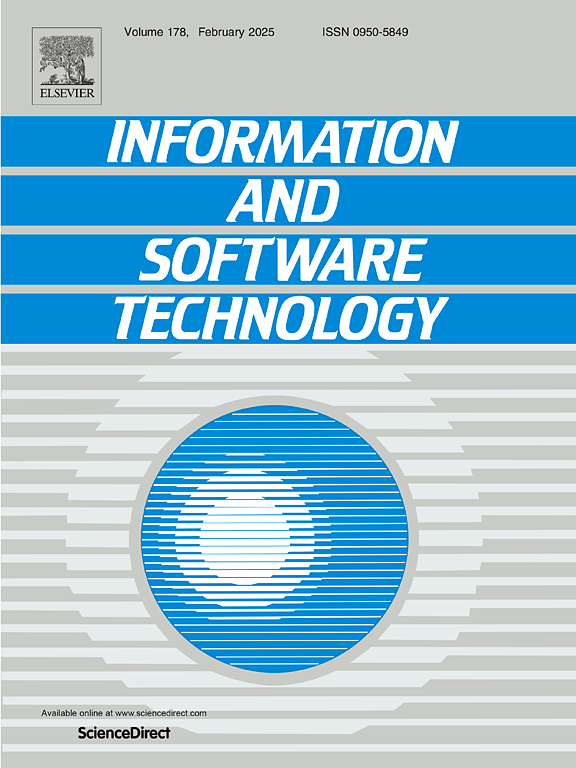更好地合作:利用深度多任务学习自动分析应用程序评论
IF 3.8
2区 计算机科学
Q2 COMPUTER SCIENCE, INFORMATION SYSTEMS
引用次数: 0
摘要
背景:移动应用程序的用户评论是开发人员与用户之间的重要沟通渠道。现有的应用程序评论自动分析方法主要一次只关注一项任务(如错误分类任务、信息提取任务等),而且往往受制于人工定义的模式以及对任务间相关性的不了解。最近,多任务学习(Multi-task Learning,MTL)已成功应用于许多场景,有望解决应用程序评论挖掘任务的相关限制。方法:MABLE 联合识别评论中报告的相关错误类型,并提取可能出现错误的细粒度特征。它由三个主要阶段组成:(1)数据准备阶段,准备数据以实现数据共享,超越单一任务学习;(2)模型构建阶段,采用 BERT 模型作为共享表示层,捕捉评论的语义,并采用特定任务层对两个任务进行并行建模;(3)模型训练阶段,通过两个相关任务之间的共享损失函数实现窃听。结果:对六款应用程序的评估结果表明,MABLE优于十款常用的和最先进的基线,在对错误进行分类时,MABLE的精确度为79.76%,召回率为79.24%;在提取问题应用程序特征时,MABLE的精确度为79.83%,召回率为80.33%。MTL机制使两项任务的F-measure分别提高了3.80%和4.63%。结论:所提出的方法为联合学习两项相关的评论分析任务提供了一种新颖而有效的方法,并为探索其他评论挖掘任务提供了启示。本文章由计算机程序翻译,如有差异,请以英文原文为准。
Better together: Automated app review analysis with deep multi-task learning
Context:
User reviews of mobile apps provide an important communication channel between developers and users. Existing approaches to automated app review analysis mainly focus on one task (e.g., bug classification task, information extraction task, etc.) at a time, and are often constrained by the manually defined patterns and the ignorance of the correlations among the tasks. Recently, multi-task learning (MTL) has been successfully applied in many scenarios, with the potential to address the limitations associated with app review mining tasks.
Objective:
In this paper, we propose MABLE, a deep MTL-based and semantic-aware approach, to improve app review analysis by exploiting task correlations.
Methods:
MABLE jointly identifies the types of involved bugs reported in the review and extracts the fine-grained features where bugs might occur. It consists of three main phases: (1) data preparation phase, which prepares data to allow data sharing beyond single task learning; (2) model construction phase, which employs a BERT model as the shared representation layer to capture the semantic meanings of reviews, and task-specific layers to model two tasks in parallel; (3) model training phase, which enables eavesdropping by shared loss function between the two related tasks.
Results:
Evaluation results on six apps show that MABLE outperforms ten commonly-used and state-of-the-art baselines, with the precision of 79.76% and the recall of 79.24% for classifying bugs, and the precision of 79.83% and the recall of 80.33% for extracting problematic app features. The MTL mechanism improves the F-measure of two tasks by 3.80% and 4.63%, respectively.
Conclusion:
The proposed approach provides a novel and effective way to jointly learn two related review analysis tasks, and sheds light on exploring other review mining tasks.
求助全文
通过发布文献求助,成功后即可免费获取论文全文。
去求助
来源期刊

Information and Software Technology
工程技术-计算机:软件工程
CiteScore
9.10
自引率
7.70%
发文量
164
审稿时长
9.6 weeks
期刊介绍:
Information and Software Technology is the international archival journal focusing on research and experience that contributes to the improvement of software development practices. The journal''s scope includes methods and techniques to better engineer software and manage its development. Articles submitted for review should have a clear component of software engineering or address ways to improve the engineering and management of software development. Areas covered by the journal include:
• Software management, quality and metrics,
• Software processes,
• Software architecture, modelling, specification, design and programming
• Functional and non-functional software requirements
• Software testing and verification & validation
• Empirical studies of all aspects of engineering and managing software development
Short Communications is a new section dedicated to short papers addressing new ideas, controversial opinions, "Negative" results and much more. Read the Guide for authors for more information.
The journal encourages and welcomes submissions of systematic literature studies (reviews and maps) within the scope of the journal. Information and Software Technology is the premiere outlet for systematic literature studies in software engineering.
 求助内容:
求助内容: 应助结果提醒方式:
应助结果提醒方式:


